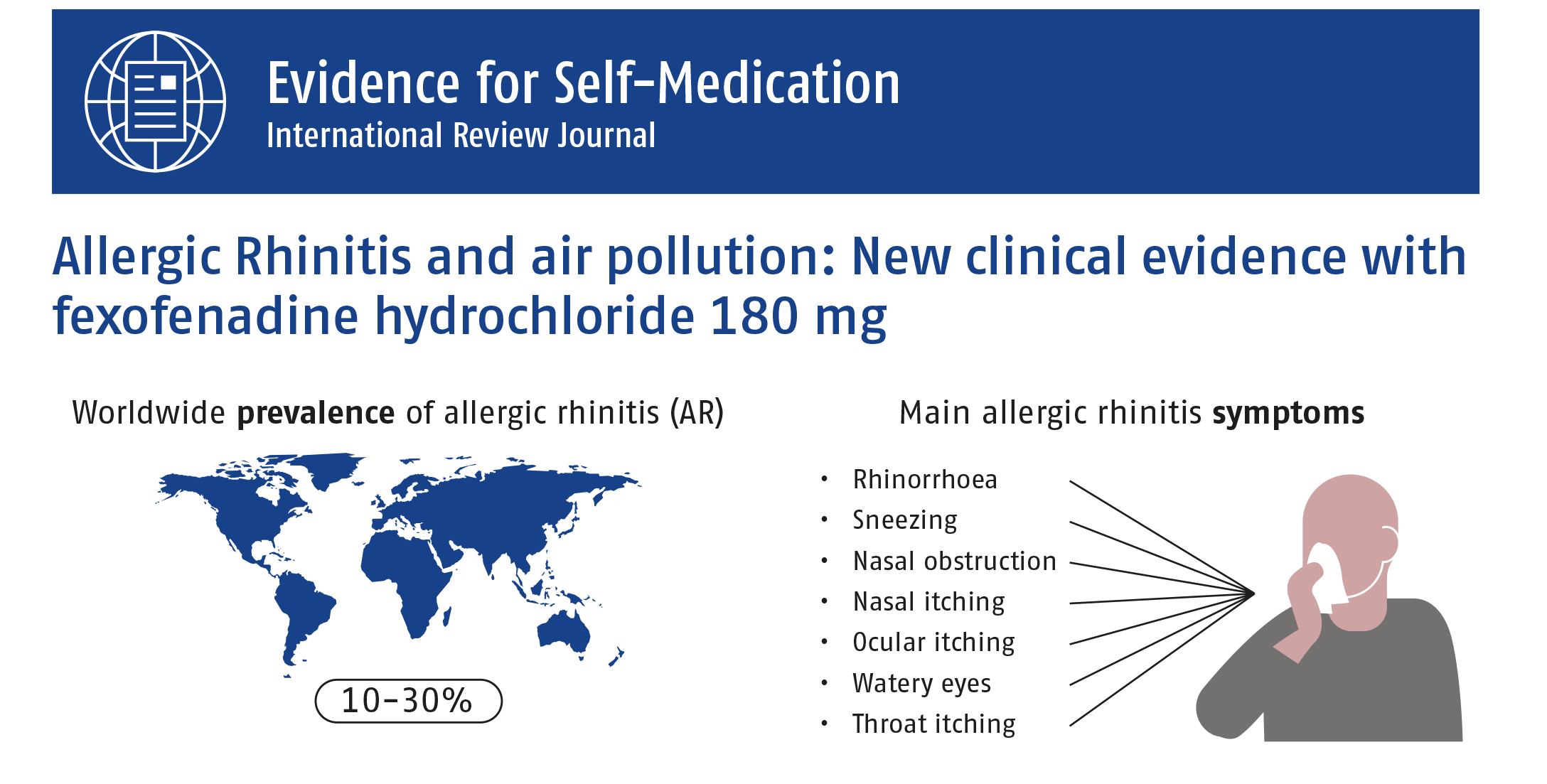Worldwide, between 10 to 30% of the population is affected by allergic rhinitis (AR) [1]. The prevalence of confirmed AR in adults in Europe range from 17% to 28.5% [2].
 Polska
PolskaAllergic Rhinitis and air pollution: New clinical evidence with fexofenadine hydrochloride 180 mg
Allergic rhinitis is an inflammation of the nasal mucosa in response to airborne allergens such as pollen or house dust mites. Leading symptoms include sneezing, nasal itching, nasal obstruction, runny nose with clear secretion and other non-nasal symptoms such as red, itchy and watery eyes. In recent decades, air pollution has been associated with an increased incidence of AR worldwide. Diesel Exhaust Particulate (DEP) is an essential component of air pollutants. They can interact with allergens and worsen the allergic reaction [3]. DEP particles infiltrate airway epithelial cells, inducing inflammation and cytotoxicity [4]. In addition, it has been observed that the interaction of DEP with allergens can enhance allergen induced responses, up to 50-times more than allergens alone [5].
Fexofenadine new evidence in AR symptoms aggravated by DEP
Their allergic rhinitis symptoms (i.e. runny nose, sneezing, itchy nose, nasal congestion) were scored up to 12 hours. Primary endpoints were the area under the curve (AUC) of the TNSS (total nasal symptom score: sum of runny nose, sneezing, itchy nose) from basal to twelve hours (AUC0–12) in periods 1 and 2, and from two to twelve hours (AUC2–12) in the treatment period 3.
Looking at the first two periods of the study, a significant increase in TNSS AUC was seen in subjects exposed to both ragweed pollen (allergen) and DEP compared to those exposed to ragweed pollen alone (Fig. 1, p<0.0001). In the third period of the study, fexofenadine HCl 180 mg significantly reduced the air pollutant-aggravated AR symptoms compared to patients receiving placebo (p=0.0148) (Fig. 2). The mean percent symptoms reduction compared to placebo related to the individual symptoms was as follows: sneezing (39.2%), rhinorrhoea (28.8%), watery eyes (27.5%), blocked nose and red or burning eyes (24.8%), nasal itching and itchy eyes (23.0%), ear, palate or throat itching (18.6%).
Fig. 1. Symptoms of allergic rhinitis due to ragweed pollen were significantly stronger with the simultaneous presence of DEP. Adapted from Ellis et al., 2021 [7].
Fig. 2. The fexofenadine group showed significantly fewer symptoms of allergic rhinitis than the placebo group after allergen exposure with the simultaneous presence of DEP. Adapted from Ellis et al., 2021 [7].
Summary
Air pollutants such as DEP can aggravate AR symptoms [5]. Fexofenadine-HCl 180 mg showed an improvement of SAR symptoms aggravated by DEP. Sneezing is particularly reduced, important for AR sufferers during the COVID-19 pandemic for when early mild COVID-19 symptoms may be confused with or co-occurrent with AR and, as uncontrolled hay fever may increase the risk of viral dissemination[11].
Literature
- Pawankar R, Canonica GW, Holgate ST et al. WAO White Book on Allergy: Update 2013: WAO; 2013.
- Brozek JL, Bousquet J, Agache I et al. Allergic Rhinitis and its Impact on Asthma (ARIA) guidelines—2016 revision J Allergy Clin Immunol 2017;140:950–8.
- Naclerio R, Ansotegui IJ, Bousquet J et al. et al. International expert consensus on the management of allergic rhinitis (AR) aggravated by air pollutants. World Allergy Organization Journal 2020;13:100106 http://doi.org/10.1016/j.waojou.2020.100106.
- Li N, Nel AE. The cellular impacts of diesel exhaust particles: beyond inflammation and death. Eur Respir J. 2006;27(4):667-8; 10.1183/09031936.06.00025006.
- Riedl M, Diaz-Sanchez D. Biology of diesel exhaust effects on respiratory function. JACI. 2005;115(2):221–8; quiz 9; 10.1016/j.jaci.2004.11.047.
- Compalati E, Baena-Cagnani R, Penagos M, et al. Systematic review on the efficacy of fexofenadine in seasonal allergic rhinitis: a meta-analysis of randomized, double-blind, placebo-controlled clinical trials. Int Arch Allergy Immunol 2011;156:1–15.
- Ellis AK, Murrieta-Aguttes M, Furey S, Carlsten C. Effect of fexofenadine hydrochloride on allergic rhinitis aggravated by air pollutants. ERJ Open Research 2021;7(2):00806-2020; DOI: 10.1183/23120541.00806-2020.
- Ellis AK, Steacy LM, Hobsbawn, B, et al. Clinical validation of controlled grass pollen challenge in the Environmental Exposure Unit (EEU). All Asth Clin Immun 2015;11:5. https://doi.org/10.1186/s13223-015-0071-3.
- Brozec JL, Bousquet J, Baena-Cagnani AE, et al. 2010 Allergic Rhinitis and its Impact on Asthma (ARIA) guidelines: 2010 revision. J Allergy Clin Immunol 2010;126(3):466–76.doi: 10.1016/j.jaci.2010.06.047.
- Day JH, Briscoe MP, A Welsh A, et al. Onset of action, efficacy, and safety of a single dose of fexofenadine hydrochloride for ragweed allergy using an environmental exposure unit. Ann Allergy Asthma Immunol 1997;79(6):533–40. doi: 10.1016/S1081-1206(10)63062-1.
- Scadding GK, Hellings P W, Bachert C, et al. Allergic respiratory disease care in the COVID-19 era: A EUFOREA statement. World Allergy Organization Journal 2020;13:100124, http://doi.org/10.1016/j.waojou.2020.100124.
Conflict of interest: M. Volonte and M. Murrieta-Aguttes are employees of Sanofi.
Disclosures: Medical Writing and Publication funded by Sanofi-Aventis Deutschland GmbH.
Preview PDF Infographic
